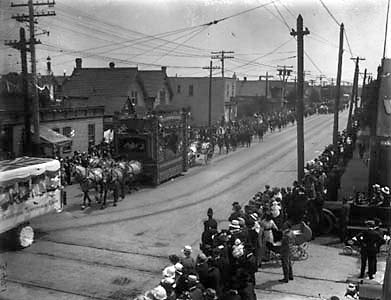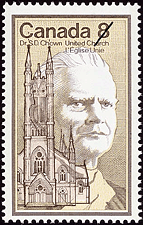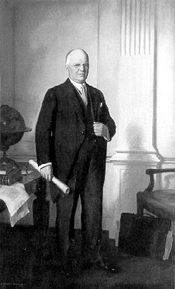Useful links
A very brief overview of the temperance movement from Women in History, Encyclopedia Britannica
A longer article from the old (1911) Catholic Encyclopedia
Another article on the WCTU from the Digital Collections, government of Canada
Richard Allen on the social gospel in Canada, from the Canadian Encyclopedia
The Canadian Mennonite Encyclopedia Online on the social gospel, and what it identifies as its political continuation, the NDP
Gerald Hallowell on Prohibition in the Canadian Encyclopedia
A PDF file (requires Adobe Acrobat) by Gerry Ediger of Canadian Mennonite University, Winnipeg, on "Working for a Christian Canada 1876-1925"
A full bibliography on the CCF and NDP, including works on its religious roots
Louise Crummy took "the pledge" as a Victorian schoolgirl, and as Louise McKinley became the first woman elected to a legislature in the British Empire (Alberta, 1917)
Nellie McClung, an active Methodist and another member of the Alberta Five, also got her start in the WCTU
Phyllis Airhart links Wesley's theology with Methodist progressivism in Canada
The Dictionary of Canadian Biography on Edward Wix, an Anglican minister in Newfoundland who supported temperance
Go to DCB and search on the word "temperance" and you'll get references to 386 other biographies
A 2003 article in the Canadian magazine Faith Today on recent evangelical attitudes towards alcohol
Print bibliography
Michael Gauvreau and Nancy Christie, A Full-Orbed Christianity: The Protestant Churches and Social Welfare in Canada, 1900-1940 (1996)
J.H. Arnup, A New Church Faces a New World (1937)
John Cormie, Canada and the New Canadians (1931)
Eric R. Crouse, "Capitalism under Fire: Voices of Baptist Social Protest in New Brunswick and Nova Scotia during the Great Depression," JCCHS 43 (2001) 39-56
Mary Rose Donnelly, Katharine: Katharine Boehner Hockin, A Biography (1992)
George Dorey et al., No Vanishing Race: The Canadian Indian Today (1955)
Stephen Endicott, James G. Endicott: Rebel out of China (1980)
Jean G. Forbes, Wide Windows: The Story of the Woman's
Missionary Society of the United Church
of Canada (1951)
W.J. Gallagher, "The Canadian Council of Churches,"
in "One Lord…": The Story of the Communions
in The Canadian Council of Churches (1955)
C. Douglas Jay, "World Mission and World Civilization" (1966-67)
Gillian A. W. Liebenberg, "'Cautious and Conservative': Anglican social policy in New Brunswick, 1906-1918," JCCHS 41 (1999): 27-55
Malcolm C. Macdonald, From Lakes to Northern Lights (1951)
Malcolm C. Macdonald, Our Heritage and Horizons in Home Missions (1961)
J.I MacKay, The World in Canada (1938)
John Moir, "The Canadian Baptist and the Social Gospel Movement, 1879-1914," in John S. Moir, Christianity in Canada: Historical Essays, ed. Paul Laverdure, Yorkton, SK: Redeemer's Vocie Press, 2002, 96-105
EA Pulker," The Social Concern of Canon Scott", JCCHS 22 (1980) 1-16 (on Frederick George Scott, padre in WW I)
Donna Sinclair, Crossing Worlds: The Story of the
Women's Missionary Society of the United Church
of Canada ( 1992)
Annie D. Stephenson, That They May Be One: An Introduction
to the Study of the Work of he Board
of Home Missions of the United Church of Canada (1929)
These Fifteen Years [on home missions] (194[0])
J.S. Thomson, The Divine Mission (1957)
Lorraine Vander Hoef , "John Dougall (1808-1886): Portrait of an Early Social Reformer and Evangelical Witness in Canada", JCCHS 43 (2001) 115-146 [editor of the Montreal Witness]
Andrew Wetmore," The Briefcase Boys," JCCHS 25 (1983) 74-92
Robert Wright, A World Mission: Canadian Protestants and the Quest for a New International Order, 1918-1939 (1991)
Phyllis D. Airhart, Serving the Present Age (Montreal and Kingston: McGill-Queen's Univ. Press, 1992
J.S. Woodsworht, My Neighbor: A Study of City Conditions, a Plea for Social Service (Toronto: Missionary Society of hte Methodist Church, c. 1911)
A.M.C. Waterman, "The Lord's Day in a Seuclar Society: A Historical Comment on the Canadian Lord's Day Act of 1906," in Canadian Journal of Theology 11 (1965): 108-123
Anglican Outlook
Christian Guardian
New Outlook
Charles R. Feilding, ed., Canada and Christendom
Brian Fraser, Social Uplifters
Fraser, Brian J. "Presbyterian Progressives and the Problem of the City in Toronto, 1891-1912." The Canadian Society of Presbyterian History Papers IV (1978): 1-20.
Laverdure, Paul. "Charles Chiniquy's the Priest, the Woman and the Confessional: Protestant 'Pornography'?" The Canadian Society of Presbyterian History Papers X (1984-1985): 59-71
________. "Canada's Sunday: The Presbyterian Contribution, 1875-1950." The Canadian Society of Presbyterian History Papers XIII (1988): 1-30
Mack, D. Barry. "The Man from Glengarry: A Theological Vision of Canada." The Canadian Society of Presbyterian History Papers VI (1980): 39-53
Moir, John S. "Competition or Co-Operation? Aspects of Presbyterian-Methodist Relations in Canada's Atlantic Region." The Canadian Society of Presbyterian History Papers XXII (1997): 47-48.
Nieuwhof, Carey. "'Eternal Vigilance': The Rise of a Legislative Agenda and the Decline in Congregational Activity in Canadian Presbyterianism, 1875-1925." The Canadian Society of Presbyterian History Papers XX (1995): 16-37
Owen, Michael. "'This Hydra-Headed Evil': Presbyterians and the Liquor Traffic, 1895-1915." The Canadian Society of Presbyterian History Papers IX (1983): [51-91]
________. "'Satan in Solution': Presbyterians and the Liquor Traffic, 1895-1915." The Canadian Society of Presbyterian History Papers X (1984-1985): 105-134
Shearman, John. "The Contribution of Rev. Hugh Pedley, D.D., of the Canadian Congregational Union, to the Formation of the United Church of Canada." The Canadian Society of Presbyterian History Papers XIX (1994): 162-175
Moral reform, social gospel, social control
 In the nineteenth century,
the sense that uncontrolled alcohol was a cause of many social ills —
domestic violence, family breakdown, unemployment, crime — brought
ordinary churchgoers, especially women, the political sphere as never
before. Pictured is a WCTU float at the front of a parade in Winnipeg,
1910, from a Manitoba historical
website.
In the nineteenth century,
the sense that uncontrolled alcohol was a cause of many social ills —
domestic violence, family breakdown, unemployment, crime — brought
ordinary churchgoers, especially women, the political sphere as never
before. Pictured is a WCTU float at the front of a parade in Winnipeg,
1910, from a Manitoba historical
website.
But how far should the churches involve themselves in political campaigns? After the defeat of prohibition in Ontario in 1926, one prominent minister, Richard Roberts, wrote :
I confess to a great misgiving about the idea that it is the business of the Church to press legislating to pass laws providing this or enforcing that. These legislative short-cuts to the Kingdom of God seem to me to be altogether illusory.
What transitions in the relationship between church and society does his comment reflect?
Is "moral reform" a kind of "social control"? Many historians would say so. In promoting social causes — temperance, Lord's day rest, film censorship, protection of children, improved labour conditions, better schooling and medical care, and many others — did the churches see themselves as custodians of social well-being? What happened to the churches' identity and sense of mission when temperance concerns were assumed by liquor-control boards, the teaching of social values was assumed by public school boards, the financial protection of the elderly was assumed by social insurance administrations, and so on?
Gender differences. How did men and women differ in their approach to temperance reform according to "'Sweeter Manners, Purer Laws'"? How do you think men and women might have differed in their approach to other moral reforms?
Temperance
| Is temperance now considered a "social gospel" issue? Why or why not? |
Moral and social reform (and temperance in particular) are often associated in the popular mind as "Methodist" concerns. Note that the readings illustrate that Methodists were not alone in promoting such causes!
 S.D. Chown,
a name that will be familiar to you after last week's tour of the archives,
was named General Secretary of the newly formed Department of Temperance,
Prohibition, and Moral Reform in 1902. Several name changes later, this
department was folded into the Board of Evangelism and Social Service
after church union, along with similar ones from the Congregationalist
and Presbyterian churches. The Board's agenda was promoted by some of
the most talented first-generation leaders of the United Church. (You'll
be reading one of the Board's major reports, "Christianizing the
Social Order," in a few weeks.)
S.D. Chown,
a name that will be familiar to you after last week's tour of the archives,
was named General Secretary of the newly formed Department of Temperance,
Prohibition, and Moral Reform in 1902. Several name changes later, this
department was folded into the Board of Evangelism and Social Service
after church union, along with similar ones from the Congregationalist
and Presbyterian churches. The Board's agenda was promoted by some of
the most talented first-generation leaders of the United Church. (You'll
be reading one of the Board's major reports, "Christianizing the
Social Order," in a few weeks.)
Methodists were alarmed by evidence of alcohol abuse, and became vigorous supporters of efforts to curtail its use. Their challenge was a daunting one. Prohibition was a provincial matter, and so the battle had to be fought on different fronts. PEI was the first to go beyond "local option" laws by passing province-wide prohibition in 1901, and the last to lift its ban in 1948. At the other end of the spectrum was Quebec with the shortest life for prohibition: legislation was enacted in 1918 but lifted the next year. All provinces except PEI opted for government-controlled sale of liquor by 1930.
Those who looked to prohibition legislation to control alcohol abuse
suffered a major setback in 1926.  Conservative
Howard Ferguson (pictured left, and described by one historian as "wily
and not entirely respectable") fought the provincial election on
a campaign to end prohibition in Ontario, and won handily. The United
Church bitterly complained that prohibition had been made into a "partisan"
issue, but now had to rethink the strategy of relying on government legislation
to help the temperance cause. In the 1930s, the Board of Evangelism and
Social Service focused on education rather than legislation. The effectiveness
of the compromise of "government control" of the use of alcohol
was contested; the United Church remained skeptical.
Conservative
Howard Ferguson (pictured left, and described by one historian as "wily
and not entirely respectable") fought the provincial election on
a campaign to end prohibition in Ontario, and won handily. The United
Church bitterly complained that prohibition had been made into a "partisan"
issue, but now had to rethink the strategy of relying on government legislation
to help the temperance cause. In the 1930s, the Board of Evangelism and
Social Service focused on education rather than legislation. The effectiveness
of the compromise of "government control" of the use of alcohol
was contested; the United Church remained skeptical.
For a discussion of the United Church's approach to social issues after union, see Ian Manson, "'Fighting the Good Fight': Salvation, Service, and Social Reform in the Board of the Evangelism and Social Service of the United Church of Canada, 1925-1945" (a Th.D. dissertation available at Emmanuel College library).
Notes on Document 3
(this week's 1st reading)
The General Synod Journal is the name given to the records of General Synod, the legislative body of the Church of England in Canada (now the Anglican Church of Canada). It meets periodically — roughly every three years. It's comprised of all active bishops, meeting as "the Upper House", and clergy and lay delegates from each of the diocesan synods, meeting as "the Lower House." Formerly the two houses sat separately, but now they sit together in the same room. The GSJ includes minutes of the session, plus reports from the various committees of the General Synod.
Judging from this document, how would you describe the Church's understanding of moral and social reform? What issues is this committee interested in? How does it discern God's will in these issues? What are its strategies? What can you tell from its financial statement?
Helps with Document 4
(this week's 2nd reading)
Excerpts relating to moral reform, Acts and Proceedings of the Presbyterian Church in Canada, 1913
Here from Stuart Macdonald are some suggestions on reading Presbyterian primary sources.
In any study of the Presbyterian Church in Canada, there are several primary sources which are frequently used: the Acts and Proceedings of the General Assembly (A&P) ,and denominational magazines, most frequently The Presbyterian Record.
Generally these are very easy sources to use, but there are always a few things to keep in mind or consider.
Acts & Proceedings
The Acts & Proceedings are exactly what they claim to be — the minutes of the national denominational meeting and the actions which arise out of the meeting.
 In Canada, the General
Assembly (national meeting) meets once a year. (Pictured left is a group
at the 2004 General Assembly in Oshawa.) One-sixth of the ministers and
one-sixth of the elders of each presbytery are delegates. The meeting
is conducted according to the rules for church courts. The current rules
are found in the denominations book of canon law, The Book of Forms.
A caution: these rules do change and in a more intense study than one
would do for this course, it would always be a good idea to be aware of
the rules in the year you are looking at.
In Canada, the General
Assembly (national meeting) meets once a year. (Pictured left is a group
at the 2004 General Assembly in Oshawa.) One-sixth of the ministers and
one-sixth of the elders of each presbytery are delegates. The meeting
is conducted according to the rules for church courts. The current rules
are found in the denominations book of canon law, The Book of Forms.
A caution: these rules do change and in a more intense study than one
would do for this course, it would always be a good idea to be aware of
the rules in the year you are looking at.
In most years the published Acts and Proceedings is divided into three basic sections:
- the minutes of the meetings which include all of the motions passed, defeated or amended
- the reports presented to the meeting with recommendations which are being discussed, debated
- other information (see below)
Typically the meeting does business by considering the recommendations of its committees; these recommendations are presented in committee reports which are circulated to members ahead of time. Therefore, to understand what's going on in any given debate, it's usually best first to read the report (which is generally found in the appendix to the Acts and Proceedings, or later in the volume) and then read the minutes to see what happened to the report and its recommendations.
Sometimes a report is considered over several different sessions (often referred to by the Latin phrase sederents meaning "sittings"). It's best to take time on reading the minutes to try to work out exactly how the report was received, and whether it was agreed with, disagreed with, or amended. One final important note: there are not to be any large blank spaces in the Acts and Proceedings. This is according to church law. Therefore, if you ever encounter a space in a report, something has been removed. (This is a hint.)
Finally, the A&P also contains at the back some statistical information of the church (such as congregational membership) and directories (such as a list of ministers and a list of congregations). This is one of its invaluable uses.
Denominational Magazines
These are much easier sources to use. The Presbyterian Record is the most commonly used source and as a denominational magazine has been dominant since 1925.
A few things to remember as you read this or any other denominational magazine:
- editors shape magazines, what is included and what is not
- editors particularly can shape the "feedback" through the "Letters to the Editor" column
Important aside. A word on Presbyterians and colour: Presbyterians have only one colour — blue. As a result, more than one book is referred to as "the blue book". Presbyterians are often able to figure out which book is meant in which context; however, it is always a good idea to check. In my experience, the following are referred to as "the blue book" and do have blue covers:
- the yearly Acts and Proceedings
- the Book of Forms
- The Book of Praise (hymn book, 1971)
- The Book of Praise (hymn book, 1997)
In referencing or conversation, avoid colour!
Some questions on the 2nd reading
What attitudes to the role of the church in shaping moral policy in society do you see reflected in these documents? (have examples, or quotes ready, to illustrate your argument)
Michael Owen has argued that Presbyterians differed from other Protestants in stressing education over legislation. Do you see evidence of this in the documents you've read? What differences (if any) do you see between the different Protestant denominations?
Why were the churches so concerned about alcohol?